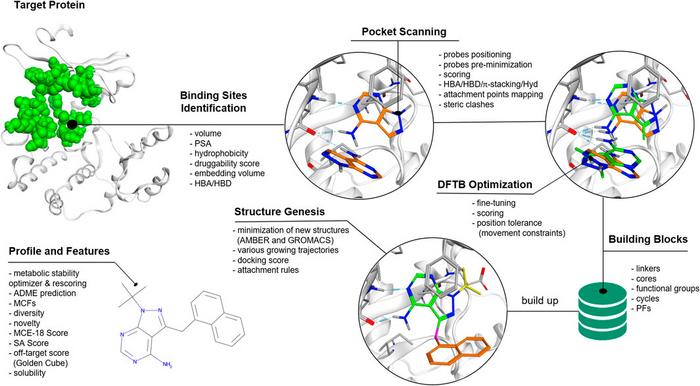A groundbreaking new algorithm called Quantum-assisted Fragment-based Automated Structure Generator (QFASG) from a team of researchers at clinical stage artificial intelligence (AI)-driven biotech company Insilico Medicine (“Insilico”) offers a meaningful step forward in automated drug design. QFASG utilizes advanced chemoinformatic techniques to construct novel small-molecule structures from a library of molecular fragments. To demonstrate its effectiveness, the researchers successfully applied QFASG to generate new small-molecule inhibitors of two pharmacological targets involved in cancer pathogenesis. The findings were published in Frontiers in Chemistry.

Credit: Insilico Medicine
A groundbreaking new algorithm called Quantum-assisted Fragment-based Automated Structure Generator (QFASG) from a team of researchers at clinical stage artificial intelligence (AI)-driven biotech company Insilico Medicine (“Insilico”) offers a meaningful step forward in automated drug design. QFASG utilizes advanced chemoinformatic techniques to construct novel small-molecule structures from a library of molecular fragments. To demonstrate its effectiveness, the researchers successfully applied QFASG to generate new small-molecule inhibitors of two pharmacological targets involved in cancer pathogenesis. The findings were published in Frontiers in Chemistry.
In recent years, AI-assisted generative chemistry platforms such as Insilico’s Chemistry42 engine – a software platform for de novo small molecule design and optimization that integrates AI techniques with computational and medicinal chemistry methodologies – have demonstrated the possibility of designing novel drug candidates from scratch using generative AI. Now, driven by advances in quantum computing and chemoinformatic techniques, researchers can explore vast chemical spaces with new speed and efficiency, allowing them to design new compounds from virtual fragments.
“QFASG generates new drug-like structures using a medicinal chemistry approach,” says Sergei Evteev, a lead researcher on the project. “By leveraging molecular fragments and advanced algorithms, we can design compounds that interact specifically with target proteins, potentially leading to detection of new promising chemotypes.”
One of the key features of QFASG is its fully automated pipeline, which streamlines the process of structure generation and optimization. The algorithm employs a two-part approach: first, probes are strategically placed within target binding sites, and then structural growth occurs through iterative modules, resulting in the generation of diverse compound libraries.
“Our goal with QFASG is to provide researchers with a powerful tool for generating primary hit compounds,” says Alex Zhavoronkov, PhD, founder and CEO of Insilico Medicine and a member of the research team. “These initial structures can serve as starting points for further optimization and development, ultimately accelerating the drug discovery process.”
To demonstrate the effectiveness of QFASG, the researchers used the algorithm to design inhibitors for two proteins that hold promise as targets for new cancer treatments: ATM and CAMKK2 kinases. ATM kinase is involved in DNA damage response and repair and is a promising target for the treatment of solid tumors, glioblastoma, sarcoma, lung, prostate and colorectal cancer and other pathologies. CAMKK2 plays a significant role in various physiological and pathological processes, including cancer cell growth and is overexpressed in multiple tumor types, including prostate, breast, ovarian, gastric and hepatic cancers
In order to test the capabilities of QFASG, the researchers performed insilico validation by reproducing binding poses of known protein ligands and in vitro evaluation of structures generated for ATM and CAMKK2. In both cases, three unique structures designed by the algorithm were selected for synthesis and testing and several compounds demonstrated low micromolar activity against the desired targets.
The researchers will continue to explore the use of QFASG for de novo generation of novel chemical structures – in particular to generate primary hit compounds and initial hypotheses that can be further explored in AI-driven generative chemistry platforms.
Insilico is a pioneer in using generative AI for drug discovery and development. The Company first described the concept of using generative AI for the design of novel molecules in a peer-reviewed journal in 2016. Then, Insilico developed and validated multiple approaches and features for its generative adversarial network (GAN)-based AI platform and integrated those algorithms into the commercially available Pharma.AI platform, which includes generative biology, chemistry, and medicine and has been used to produce a robust pipeline of promising therapeutic assets in multiple disease areas, including fibrosis, cancer, immunology and aging-related diseases, a number of which have been licensed. Since 2021, Insilico has nominated 18 preclinical candidates in its comprehensive portfolio of over 30 assets and has advanced six pipelines to the clinical stage. In March 2024, the Company published a paper in Nature Biotechnology that discloses the raw experimental data and the preclinical and clinical evaluation of its lead drug – a potentially first-in-class TNIK inhibitor for the treatment of idiopathic pulmonary fibrosis discovered and designed using generative AI that is currently in Phase II trials with patients.
About Insilico Medicine
Insilico Medicine, a global clinical-stage biotechnology company powered by generative AI, connects biology, chemistry, and clinical trial analysis using next-generation AI systems. The company has developed AI platforms that utilize deep generative models, reinforcement learning, transformers, and other modern machine learning techniques for novel target discovery and generating novel molecular structures with desired properties. Insilico Medicine is developing breakthrough solutions to discover and develop innovative drugs for cancer, fibrosis, immunity, central nervous system diseases, infectious diseases, autoimmune diseases, and aging-related diseases. www.insilico.com
Journal
Frontiers in Chemistry
Article Title
Quantum-assisted fragment-based automated structure generator (QFASG) for small molecule design: an in vitro study
Article Publication Date
3-Apr-2024



